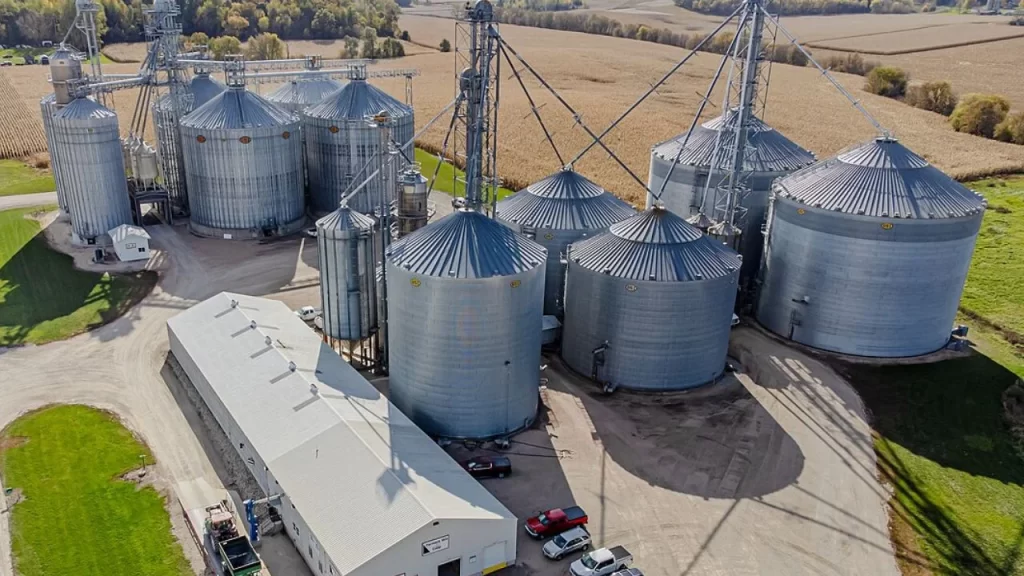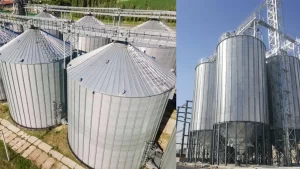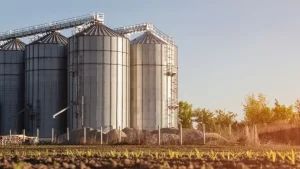Grain storage silos are a vital part of modern agriculture, not just for storing grains after harvest but also for preserving planting seeds. As farming operations grow in scale and complexity, the need for reliable and efficient seed storage becomes more critical. In this blog, we will explore the essential role of grain storage silos in storing planting seeds and how they help ensure agricultural sustainability, quality, and long-term success.
That’s where silos come into play – large-scale grain storage silos. Farmers and big businesses prefer silos for their efficiency in storing large quantities of grain. Silos are not only used for storage, they are also used for harvesting and preparing the grain for distribution
The amazing part of silos is that they are not just big bins, they protect your grains from harmful pests—like bacteria, insects, and fungi—that can ruin your grain. Silos seal up tight, functioning as a shield to pesky weevils. Silos also help get rid of any bugs or germs in the stored grain, making it top-notch quality for export or distribution.

What is the history of grain storage silos in agriculture?
In the past, people sought clever ways to store grain for long winters. So, they started with baskets, sacks, and jars. Some even had special storehouses where grain formed big piles, doubling as a cool hangout for hunter-gatherers.
But these methods also had issues. Jars and sacks were only good for short-term and tiny bits of grain. Open storehouses? Total grain buffet for rats, bacteria, bugs, and more.
Around 11,000 years ago, silos emerged as a smart solution to fight famine. Barley and wheat were the VIPs in these silos. Back in 1873, Fred Hatch, a farmer from McHenry County, Illinois, designed America’s first modern silo. This ingenious move started a trend. Gradually, more silos started popping up across the country, although some people weren’t entirely on board with the idea.
In the 20th century, steel silos took center stage. They become the go-to choice, pushing aside other types of silos in the grain storage plant system. In fact, around 95% of silos in the United States are made of steel. The design and construction tech for steel silos didn’t just stop there, it kept evolving, making the steel silo the ultimate grain guardians
From makeshift jars to high-tech steel, the story of grain silos is a journey from basic to brilliant, ensuring our grain stays safe and our winters well-fed.
What are the different types of silos?
There are several types of silos used in agriculture, each designed to meet specific storage needs based on factors like grain type, storage capacity, and environmental conditions. Vertical silos are the most common, typically made of steel or concrete, and are designed to store large quantities of grain in a compact, cylindrical structure.
These silos offer efficient space utilization and are equipped with features like aeration systems to control temperature and humidity. Bunker silos are large, open, rectangular structures often used for silage or grains that require bulk storage.
Though more cost-effective than vertical silos, they lack the climate control features of more advanced options. Flat storage silos are another type, designed for short-term storage needs. These structures have a flat roof and are often used when quick storage of grain is necessary. Finally, bin silos are smaller, modular storage units that are particularly useful for on-farm storage. They are customizable and allow farmers to store various types of grains separately. Each silo type plays a unique role in enhancing the efficiency and longevity of grain storage, with the choice largely depending on the scale and requirements of the farming operation.
Tower silos
Tower silos are a specific type of vertical silo commonly used for storing grain, silage, and other bulk materials. These silos are tall, cylindrical structures that offer efficient vertical storage, allowing for a large capacity in a relatively small footprint. Tower silos are typically made of materials like steel, concrete, or wood, with steel being the most common due to its durability and ability to withstand environmental stresses.
Low-oxygen tower silos
Low-oxygen tower silos are a specialized type of storage silo designed to preserve grains, silage, and other agricultural products by reducing the oxygen levels inside the silo. The primary goal of these silos is to create an environment that slows down the natural degradation processes that occur when oxygen is present, such as mold growth, fermentation, and pest infestations.
Bunker silos
Bunker silos, the heavy lifters of material storage, feature sturdy concrete walls, forming trenches for storing large loads. Tractors and loaders fill these trenches to capacity. Bunker silo storage plant system is used for bulk materials storage.
Once we’ve got everything neatly packed, we seal the deal with a plastic tarp, making it airtight. These silos mean serious business. When it’s time to unload, it involves the reliable tractor and loader combo.
Bunker silos are not just for farms; they’re a powerhouse solution for industries dealing with hefty material quantities. Even the military’s recognizing their strength, using bunker silos for missiles. That’s right, these silos aren’t just heavy-duty; they’re business-ready, tackling big storage challenges.
Bag silos
Bag silos are essentially plastic and airtight bags or tubes used for on-field storage of grains and fodder. Ranging from 2 to 21 meters in diameter, the length adapts to the specific material in storage.
These silos bear considerable weight. A purpose-built machine compacts and seals these heavy-duty bags on both ends, ensuring a robust storage setup. What sets them apart? They’re not just practical; they’re budget-friendly, offering an economical choice for storage.
In essence, bag silos storage plant systems offer a streamlined and cost-effective approach to on-field storage, seamlessly adapting to various materials with efficiency and precision.
Best practices for successful seed storage
1. Choose the Right Storage Container
- Airtight Containers: Seeds should be stored in containers that protect them from moisture, air, and pests. Airtight containers such as glass jars, plastic buckets with tight-fitting lids, or vacuum-sealed bags are ideal.
- Proper Size: Choose containers that fit the quantity of seeds being stored. Avoid using large containers for small amounts, as excess air can cause the seeds to degrade.
2. Control Temperature
- Cool, Stable Temperature: Store seeds in a cool, dry location, ideally at temperatures between 32°F (0°C) and 50°F (10°C). Extreme temperature fluctuations should be avoided as they can lead to condensation and seed deterioration.
- Avoid Heat Sources: Do not store seeds near heat sources like radiators, hot pipes, or direct sunlight, as heat can significantly reduce the seed’s viability.
3. Maintain Low Humidity
- Dry Conditions: Moisture is one of the most significant threats to seed longevity. Seeds should be stored in low-humidity conditions (around 20–30% humidity). Excess moisture can cause seeds to rot or germinate prematurely.
- Desiccants: To further reduce humidity, place a silica gel packet or another desiccant inside the storage container. This helps absorb any excess moisture that might be present, especially in high-humidity environments.
4. Ensure Proper Ventilation
- While it is important to maintain airtight conditions to avoid moisture, adequate ventilation is still necessary to prevent mold growth. Some containers, like mesh bags or perforated plastic bags, allow for air circulation while still protecting seeds from moisture and pests.
5. Store Seeds in a Dark Place
- Avoid Light Exposure: Light can degrade the quality of seeds, affecting their viability and germination rates. Store seeds in dark places, such as basements, cupboards, or other dark storage rooms, away from windows or direct light sources.
6. Fungicides for disease control
Don’t let smut and bunt diseases crash your seed. Get wise advice on which fungicides to use for your planting seeds. Remember, not all fungicides are equal, some might affect seedling coleoptile length. Collaborate with your seed grader, understand their strategies, and treat only the seeds you’re planting. Fungicide-treated seeds won’t cut it in the grain markets.
In a nutshell, these practices are the backbone of a successful industrial grain storage plant system – from keeping it cool and clean to regular check-ups and protective measures, it’s a holistic approach to ensuring your seeds stay in top-notch quality.
Why is storage of grains in silos important?
In India, annual storage has been estimated at 14 million tons of grains worth Rs. 7000 crores going down the drain every year due to storage losses. Insects take a huge bite out of this, causing financial losses close to Rs. 1,300 crores.
It’s not just about consumption – contamination plays a role too. With around 600 types of insects hitching a ride on stored grains, Nearly 100 types of pests are responsible for economic losses, and that’s a significant hit.
According to a World Bank Report, India faces post-harvest losses ranging from 12 to 16 million metric tons of food grains each year.
Wrap your head around this – that could feed a third of India’s poor. Pests alone contribute 2.0 to 4.2 percent of these losses, followed by rats at 2.50 percent, birds at 0.85 percent, and moisture at 0.68 percent. It’s like losing a chunk of the nation’s wealth to preventable factors.
Why do we store grains?
We store grains for several key reasons, primarily to ensure food security, maintain supply consistency, and reduce post-harvest losses. Grains like wheat, rice, and corn are staples in global diets, and their storage helps bridge the gap between harvest seasons, allowing for year-round availability. By storing grains, farmers, and agricultural businesses can manage supply more effectively, preventing shortages during periods of low production or unforeseen events like crop failures or natural disasters.
Proper storage also helps preserve the nutritional quality of grains, protecting them from spoilage, pest infestations, and moisture-related issues that can lead to mold or rot. Additionally, grain storage enables farmers to take advantage of market prices by holding onto grains until demand is higher, improving their profitability. On a larger scale, grain storage facilitates global trade, as countries with surplus grains can export them to regions with lower production. Ultimately, storing grains is essential for ensuring that the world’s food systems remain stable, efficient, and resilient to the challenges posed by changing climate conditions, population growth, and fluctuating market dynamics.
How long can grains be stored?
If you’re considering the duration of grain storage for the long haul, it’s a wise consideration. The lifespan of grains varies, but here’s the lowdown:
- Hard grains: These sturdy grains can endure for 10 to 12 years with proper storage. Nail the storage techniques, and you might stretch their shelf life to a remarkable 30 years or more.
- Soft grains: They’re a bit more delicate, lasting around 8-year. Yet, with meticulous storage, you could extend their longevity to a respectable 20+ years
So, how long can grains be stored?
With proper storage and regular monitoring, grains can maintain their quality for 8 to 12 years. Storing in smaller quantities makes it easier to environmentally control, though it doesn’t mean you’re limited to a few ounces. You can still store several pounds with the right containers.
- Corn: A heavyweight in the longevity game, corn can last for 15 years or more in ideal conditions. But with temperature fluctuations, a safe bet is 10-12 years with vigilant monitoring.
- Wheat: This hard grain lasts around 8-12 years when stored in an airtight container in a cool, dry spot. Regular checks ensure it stays in good condition.
- Quinoa: A nutritional powerhouse, quinoa requires a bit more effort for long-term storage. Keep moisture low, oxygen minimal, and the storage cool. With the right care, quinoa can maintain its freshness for up to 8 years in good glass containers.
Factors affecting grain storage
In the biotic factors, we are dealing with living organisms that can wreak havoc on crops. Pests, weeds, insects, and rodents – these are the troublemakers. There’s a whole squad of about 100 different insect species that are notorious grain destroyers. You’ve got rice moths, beetles, rice flour beetles, Indian meal moths – they’re not picky and go after grains like wheat, barley, rice, millet, pulses, nuts, maize, and dry fruits.
Fungi like Penicillium and Aspergillus; they not only disrupt crops but also release toxins, making them downright poisonous. And these toxins stick around; no purification process can bid them farewell. Even the excretions and waste left behind by these insects on the grain’s surface are considered seriously harmful.
Abiotic compounds
Apart from living organisms, non-living factors like air quality, humidity, and temperature – the abiotic elements can throw a serious curveball at grain storage plant systems. If the balance between quantity and quality goes out of whack, these factors can adversely affect grain storage. A meticulous balance is essential to ensure the safety of your grains during storage.
Advantages of grain storage silos
1. Long-Term Preservation
- Silos provide a controlled environment that helps maintain the quality and freshness of stored grains over long periods. They regulate temperature, humidity, and airflow, which prevents spoilage, mold, and pest infestations, ensuring that the grain remains safe for consumption or further processing.
2. Increased Storage Capacity
- Silos, especially large-scale vertical silos, allow for the efficient storage of large quantities of grain in a relatively small area. Their vertical design maximizes space utilization, making it possible to store significant volumes of grain without requiring a large footprint. This is especially important for large farms and grain storage facilities.
3. Protection Against Pests and Rodents
- Properly sealed silos help to protect grain from pests, insects, and rodents that can infest and damage stored grain. The airtight and often sealed nature of silos ensures that pests cannot easily access the grain, reducing the need for chemical treatments and minimizing the risk of contamination.
4. Temperature and Moisture Control
- One of the most significant advantages of silos is their ability to regulate temperature and humidity levels within the storage environment. By controlling these factors, silos prevent moisture from accumulating, which can lead to spoilage, mold growth, or the degradation of grain quality. Many silos are equipped with aeration systems to ensure even airflow, enhancing the preservation of grains.
5. Efficient Handling and Movement
- Silos are designed to facilitate easy handling and movement of grain, which reduces the time and labor required for loading, unloading, and transporting the stored material. Automated systems such as conveyors, augers, and grain elevators are often integrated into silos, making grain transfer more efficient and minimizing manual effort.
6. Reduced Risk of Spoilage
- The sealed environment inside silos helps to minimize exposure to external elements, such as rain, humidity, and temperature fluctuations, which can cause grain spoilage. By maintaining a stable environment, silos reduce the risk of loss due to poor storage conditions.
7. Improved Grain Quality
- Storing grain in silos helps preserve its nutritional value, appearance, and taste. The controlled environment reduces the chances of grains becoming stale, moldy, or infested with insects, ensuring that the grains retain their intended quality for longer periods.
8. Flexibility in Storage
- Silos offer flexibility in the types of grains and materials that can be stored. Some silos are designed for specific crops like wheat or corn, while others are versatile enough to store a variety of grains, silage, or even other bulk materials. This makes silos ideal for both on-farm and large-scale commercial grain storage operations.
9. Cost-Effective
- Although silos involve an initial investment, they provide a cost-effective solution over time by reducing spoilage, losses, and the need for frequent handling. Their ability to preserve grain quality also means that farmers can sell or use grain at more favorable times, potentially leading to higher returns.
10. Space Efficiency
- Silo storage is much more space-efficient compared to traditional bulk storage methods like open-air piles or bunkers. With silos, grain can be stored vertically, which reduces the overall area needed for storage. This is especially valuable for farms or grain storage facilities with limited space.
In conclusion:
Grain Storage silos are a vital component of modern agriculture, providing a secure and efficient solution for storing large quantities of grain. Their ability to regulate temperature, humidity, and airflow helps preserve grain quality, reduce spoilage, and protect against pests, ensuring that grains remain viable for longer periods. Silos also offer significant benefits such as increased storage capacity, cost-effectiveness, and enhanced operational efficiency, making them a valuable investment for both small-scale and large-scale agricultural operations. By maintaining optimal storage conditions, silos not only help farmers preserve their harvest but also enable them to manage supply, reduce losses, and maximize profitability. With the ever-increasing demand for food and the challenges posed by climate change, grain storage silos play a crucial role in ensuring food security and supporting the global agricultural supply chain.
Website: https://www.prairiespartners.com/
Mobile: +919310139381
Email: info@prairiespartners.com


